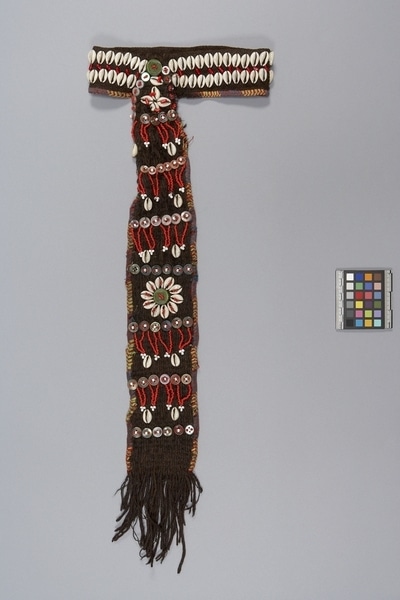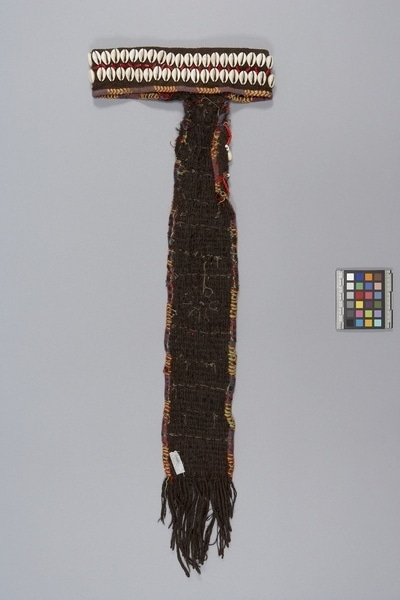Headdress Item Number: 1498/1 from the MOA: University of British Columbia


Description
A woman’s headdress made from coarsely woven dark brown wool textile. Consisting of a headband and an attached narrow “tail” or streamer that hangs down the back. Lavishly decorated with cowrie shells, red, and white glass beads, buttons, and embroidery. The headband is embellished with two rows of cowrie shells separated by a row of red glass beads. The bottom edge of the headband is finished with multi-coloured embroidery resembling a braid. The “tail” is trimmed with many buttons, red, and white glass beads, and cowrie shells forming floral and geometric shapes. The bottom is fringed (about 13.5 cm) and the side edges are finished with red, blue, and yellow-green embroidery resembling a braid. The textile used to construct the headband is woven in plain weave while the streamer is made from warp yarns which have been braided and loosely woven together to form a fabric.
History Of Use
Worn daily, both in public and in private. At festive occasions, the shusut is worn underneath a larger, more elaborate headdress, called a kupas (see 1498/2). Girls receive their first headdress at about age 7 at an initiation rite. A woman must not go bareheaded; if the headdress is taken off for cleaning, the woman must wear a shawl over her head.
Iconographic Meaning
Cowries symbolize female sexual parts and therefore invoke fecundity.
Narrative
The Kalash are geographically isolated in several valleys in northern Pakistan, close to the Afghan border. Although they are surrounded by Islamic peoples, their religion is polytheistic, with a Vedic pantheon. Linguistically, however, they are related to Afghani and the languages of Swat.
The long “tail” of the shushut is thought to have evolved from long, loose fringes. The dark brown wool textile may have been dyed with walnuts. The shells, bark and nuts themselves are used to obtain a dark colour.
Item History
- Made in Chitral, Northwest Frontier, Pakistan
- Owned by Marta Friesen before January 13, 1992
- Received from Marta Friesen (Donor) on January 13, 1992
What
- Name
- Headdress
- Identification Number
- 1498/1
- Type of Item
- headdress
- Material
- wool fibre, goat hair fibre ?, cotton fibre ?, cowrie shell, glass, plastic and dye
- Manufacturing Technique
- woven, braided, embroidered, appliqued and sewn
- Overall
- height 75.0 cm, width 25.5 cm, depth 3.0 cm
Who
- Culture
- Kalash
- Previous Owner
- Marta Friesen
- Received from
- Marta Friesen (Donor)
Where
- Holding Institution
- MOA: University of British Columbia
- Made in
- Chitral, Northwest Frontier, Pakistan
When
- Ownership Date
- before January 13, 1992
- Acquisition Date
- on January 13, 1992
Other
- Item Classes
- textiles
- Condition
- good
- Accession Number
- 1498/0001